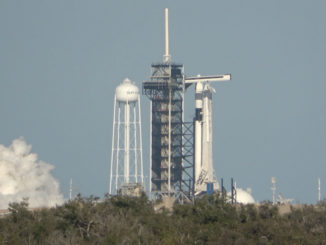
SpaceX technicians are attaching a Japanese communications satellite to the top of a Falcon 9 rocket ahead of a planned launch Thursday morning from Cape Canaveral.
The JCSAT 14 communications satellite, made in California by Space Systems/Loral, is fueled and encapsulated inside the Falcon 9 rocket’s payload fairing. Workers were expected to connect the satellite with the launcher’s second stage inside the Falcon 9 hangar as soon as Monday.
The rocket passed a key preflight test Sunday evening, when SpaceX’s launch team fueled the Falcon 9 with super-chilled kerosene and liquid oxygen and fired its nine Merlin 1D first stage engines for several seconds at Cape Canaveral’s Complex 40 launch pad.
Hold-down restraints kept the rocket on the ground during the brief static fire test, a customary all-up check of the Falcon 9 and its ground systems before the real countdown begins.
The static fire occurred without the mission’s satellite payload on-board, and SpaceX planned to return the rocket to its hangar, where the JCSAT 14 spacecraft and the Falcon 9’s nose cone were scheduled to be added.
The Falcon 9’s fourth launch of the year is set for 1:21 a.m. EDT (0521 GMT) Thursday at the opening of a two-hour launch window.
There is an 80 percent chance of favorable weather for Thursday’s launch attempt, according to the official launch forecast issued by the U.S. Air Force’s 45th Weather Squadron.
A late-season frontal boundary is approaching Florida early the week, with rain and thunderstorms in the forecast for Wednesday.
“On Wednesday, more widespread rain and thunderstorms associated with the frontal boundary will move through the spaceport,” forecasters wrote in the Air Force weather outlook. “A few of the storms may contain hail and strong winds. The front is expected to be south of the area, with conditions clearing by the launch window.”
The primary weather concerns for Thursday morning are liftoff winds and the thick cloud rule, the Air Force weather team wrote in their forecast.
The outlook calls for scattered clouds at 12,000 feet and 28,000 feet, northwest winds at 20 to 25 mph, and a temperature of 68 degrees Fahrenheit at launch time.
If the launch is delayed to Friday morning, conditions should improve somewhat with a 10 percent chance of weather violating one of the Falcon 9 weather rules.
Owned by SKY Perfect JSAT Corp. of Tokyo, JCSAT 14 will provide television broadcast programming, data network services and broadband Internet connectivity across Asia, Russia, Oceania and the Pacific islands for a 15-year mission.
The Falcon 9 will deploy the JCSAT 14 satellite in an egg-shaped geostationary transfer orbit about a half-hour after liftoff, and the spacecraft’s on-board thrusters will steer it into a circular orbit nearly 22,300 miles (about 35,700 kilometers) over the equator within a few weeks.
The distant orbit targeted by Thursday’s launch will require almost all of the Falcon 9’s propellant load, leaving little leftover fuel for landing maneuvers to touch down on a platform floating several hundred miles east of Cape Canaveral in the Atlantic Ocean.
“Following stage separation, the first stage of Falcon 9 will attempt an experimental landing on the ‘Of Course I Still Love You’ droneship,” SpaceX said in a post on the company’s website. “Given this mission’s GTO destination, the first-stage will be subject to extreme velocities and re-entry heating, making a successful landing unlikely.”
SpaceX successfully landed a rocket on the drone ship for the first time last month after a launch from Cape Canaveral with a Dragon supply ship. That mission went into low Earth orbit on the way to the International Space Station, requiring less speed than the orbit targeted on Thursday’s flight.
Email the author.
Follow Stephen Clark on Twitter: @StephenClark1.



